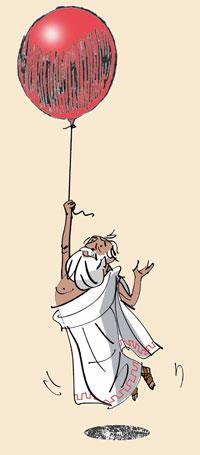The old alchemical elements were ancient Greek: earth, air, fire and water
The old alchemical elements were ancient Greek: earth, air, fire and water. I reckon the basic idea was some vague notion of density (though they didn’t have our modern concept). Earth is denser than water, and sinks in it; air is lighter than water and rises in it; fire is even lighter than air and climbs in it (even in air, smoke and flame go up).

Between them, the four elements seemed to make sense of the Greek earthly world. But the scheme did not satisfy Aristotle. He felt that the sky was different, and more perfect. The changeless moon and Sun, the stars which travel in exact circles, and even the planets seemed to imply another element. So Aristotle invented a fifth element, quintessence.
Aristotle’s quintessence fits my notions of density. It was extremely light, even lighter than fire. It seems not to occur to any extent in earthly objects. But it was plentiful in the celestial world, which these days we call space.
In the form of the ether, quintessence may even have survived into Victorian science. It filled the best vacua, and all space. It was the vibratory medium through which light travelled, rather as sound travels through air. Light goes so much faster than sound that the ether had to be extremely rigid, and to have an incredibly low density.
When Maxwell said that light was an electromagnetic radiation which did not need a vibratory medium, the ether began its slow death. Yet even now it is not quite dead. The speed of light is still special: Einstein’s relativity links it with gravity. Worse, gravity refuses to link up with quantum mechanics. The weak and strong nuclear forces are alleged to be exchange-forces transmitted by mesons. The electromagnetic force is alleged to be an exchange-force mediated by photons. But gravity declines to enter the scheme. Every attempt to reduce it to an exchange-force mediated by so-called gravitons has failed. Nobody has ever spotted a graviton. Furthermore, thanks to the uncertainty principle, space itself has become pregnant with short-lived particles. Quintessence may yet manifest itself in modern science.
Meanwhile, earth, air, fire and water fitted the chemical facts rather broadly. The Greeks knew that wood floats between water and air; on my guess about density, they would have expected it to contain water and air. But they reckoned it also contains fire and earth.
On being burnt, it produces a gas (air) and a liquid (water), releases fire, and leaves an ash (earth). We can be much more exact these days. The lowest density, that of a vacuum, is zero. Water has a density of 1000 kg/m3. The lowest density for a solid is that of solid hydrogen, 89 kg/m3, while iridium has the highest density of any element, at 22 550 kg/m3. Nothing gets much denser.
Technologists resent these limits. For balloons, they have to choose between hydrogen (cheap but highly inflammable) and helium (safe but highly expensive).
We’d like high densities too. The solid shells fired against armour are largely depleted uranium, of some 19 050 kg/m3. Military folk would welcome something denser. Many aircraft have light control surfaces balanced by a strip of heavy alloy on the other side of a pivot. Joe Smith, discussing a proposed new wing for the immortal Spitfire fighter aircraft, when told that a counterbalance of lead would not fit in the narrow wing, said ’well, we must use gold.’
Yet, to exceed our upper bound of density, we have to accompany Aristotle to the celestial world. Certain stars are thought to contain collapsed nuclear matter. Even depleted uranium consists of atoms in which a tiny nucleus is surrounded by huge shells of almost weightless electrons. If we could get rid of those electrons, and pack the nuclei tightly together, we could get a solid of up to 1018 kg/m3. Nature may have already done it for us; but only in a few stars.
David Jones












No comments yet